Today, digital marketplaces go hand-in-hand with social networks. This collaboration has forever changed the way customers interact with service providers and brands.
The latest trends have resulted in a new business model called “market network”.
In this article, we will discuss this new type of online platform. You will find out how to distinguish them from traditional marketplaces and learn the key components of a successful market network.
Also, you will know what industries will benefit the most from adopting the new business model.
What is a market network?
James Currier, a Silicon Valley venture capitalist, introduces the term “market network” in his article The Next 10 Years Will Be About "Market Networks" written for the NFX blog.
Currier predicts that soon all freelancers and their clients will communicate and do business on the market network of their industry. Their future influence on the lives of millions of people cannot be underestimated.
Market networks will have a massive positive impact on how millions of people work and live, and how hundreds of millions of people buy better services.
- James Currier, Managing Partner, NFX
So what does this term basically mean? As the name indicates, a market network is a medium that combines the main features of an online marketplace and a social network.
On the one hand, such platforms remind socials. They enable professionals to create a profile to showcase their works and communicate and build relations with people having similar interests.
On the other hand, they are similar to online marketplaces, as they offer a specific medium where customers can find the right service providers and make a transaction.
Besides, a market network is partly a SaaS platform since it provides users with particular tools for negotiating, collaborating, and managing their paperwork.
Schematically, a market network looks the following way:

For example, Contently, a high-rated content-marketing platform, provides publishers with software to create original marketing collateral and measure its effectiveness. At the same time, the website offers storytellers and journalists tools to manage their careers.
To sum up, market networks concentrate on complex services that require active human interactions or benefit users who are members of a large community.
Chris Dixon, a famous American Internet entrepreneur, and investor, accurately expresses the very essence of a network marketplace by saying that people using such mediums "come for the tool, stay for the work”.
The anatomy of a great market network
All market networks have a similar structure. They have specific components that distinguish them from other marketplaces like Amazon or eBay.
Xinova, the first innovation market network, suggests the following structure of this new type of online platform.
The list of features that turn an online platform into a market network:
- SaaS platform;
- Elements of both social networks (profiles to reflect the person’s identity, the ability to communicate with other people within the same system) and marketplaces (transactions between multiple buyers and sellers);
- Extensive ecosystem of professionals;
- Transparency in working processes and communication ;
- Lower transaction fees;
- Simplified legal contracts.
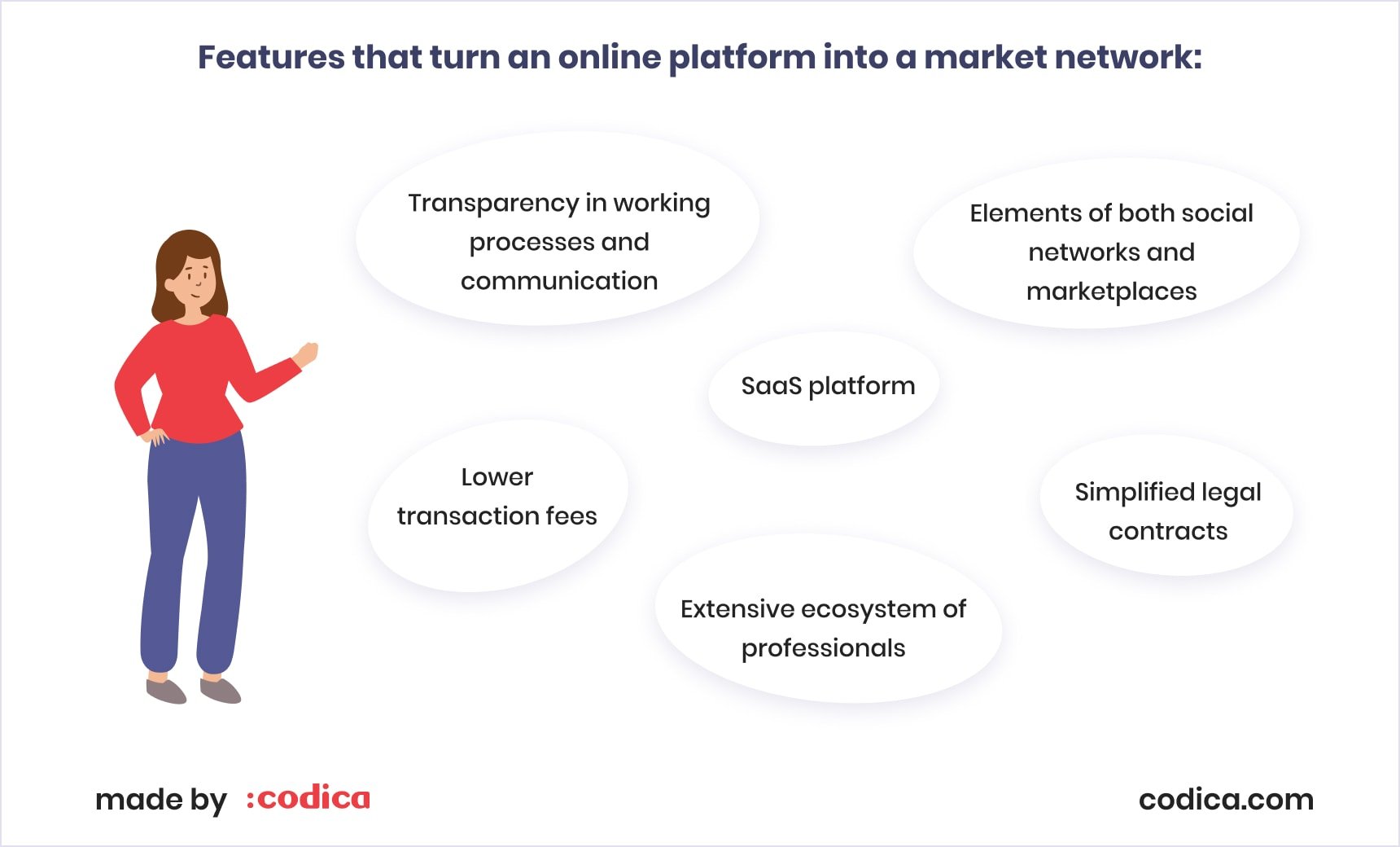
You may also like: How to Start Your Own Online Marketplace: 5 Useful Tips You Should Know
Examples of market networks
1. AngelList
The website connects angel investors with people searching for a job at startups. Naval Ravikant and Babak Nivi launched AngelList in 2010 with the mission of helping innovative companies fix their challenges related to fundraising and talent acquisition.
At the very beginning, only founders or investors with a very strong network could access all the information published on AngelList. However, later Ravikant and Nivi softened the rules to make it easier for both business owners and investors to get started.
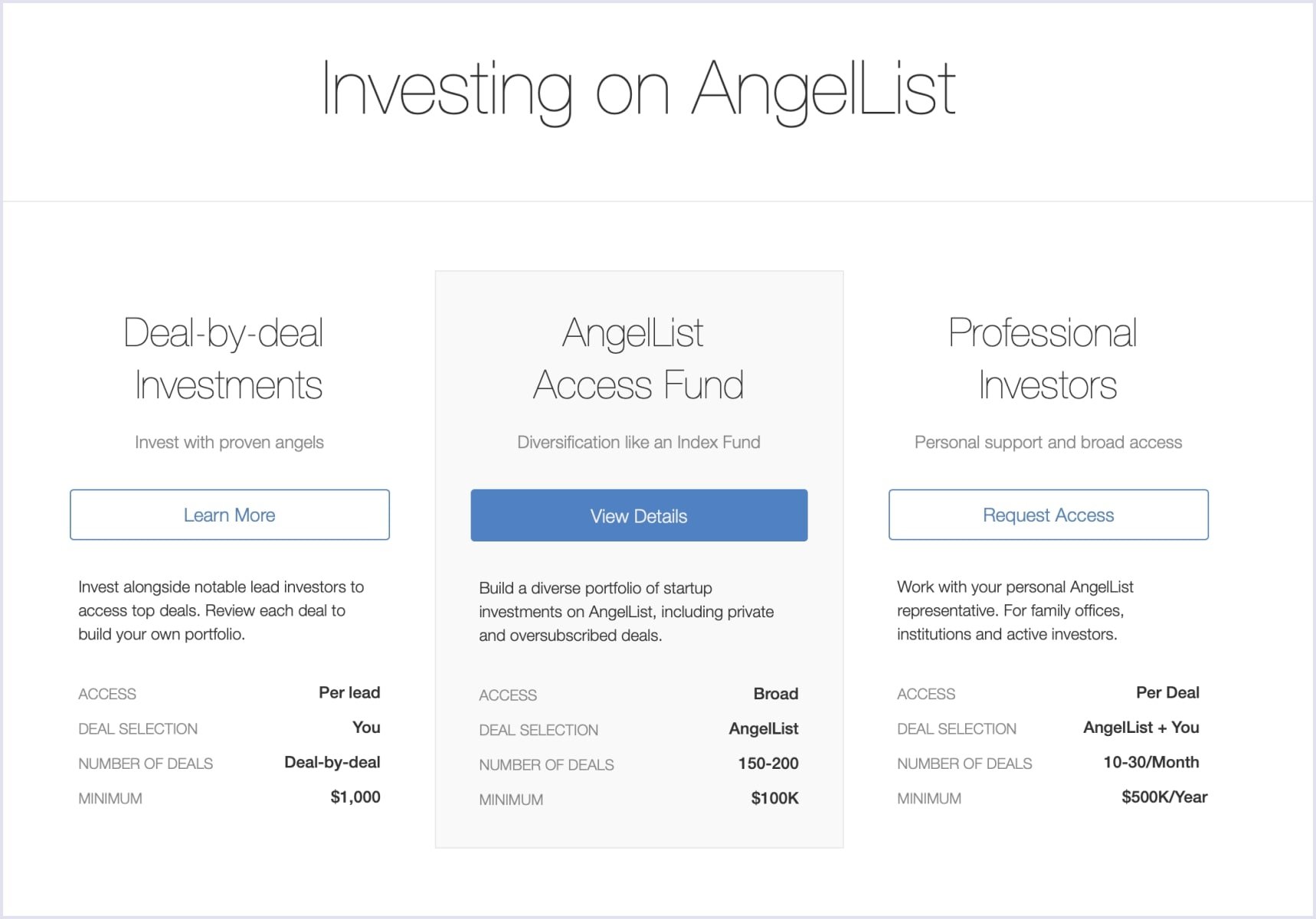
Initially, the platform had 50 Angel Investors ready to provide startups with the financial support of $80 million. Now the number of investors and startups on this network marketplace has grown to 50,000 and 75,000 correspondingly, and the deal flow there exceeds $200 million per year.
In 2018 this market network achieved remarkable results. According to their AngelList Year in Review, 2018, they reached over $1 billion in assets under management, helped over two million candidates in their job search, and assisted business owners in launching more than 20,000 revolutionary tech products.
2. Houzz
This home improvement marketplace platform was launched to allow people who contemplate the idea of remodeling their homes to interact with interior designers. When Adi Tatarko and Alon Cohen were redesigning their home, they realized how difficult it was to find the proper specialists for their project. That’s how Houzz was founded.
Houzz has an extensive directory of landscape architecture, home builders, plumbers, electricians and other professionals. They can contact homeowners, show their previous works, discuss projects they were working on, and finally get a job.
Householders, in their turn, take inspiration from numerous photos. They can use different criteria such as room, style, location, wall colour, floor material, etc and bookmark them in personal collections that are called “ideabooks”.
In 2013, Tatarko and Cohen added an interactive tool called Real Cost Finder, which made it easier for users to plan home redesign and total costs.
Here you can see some bright ideas for your living room.
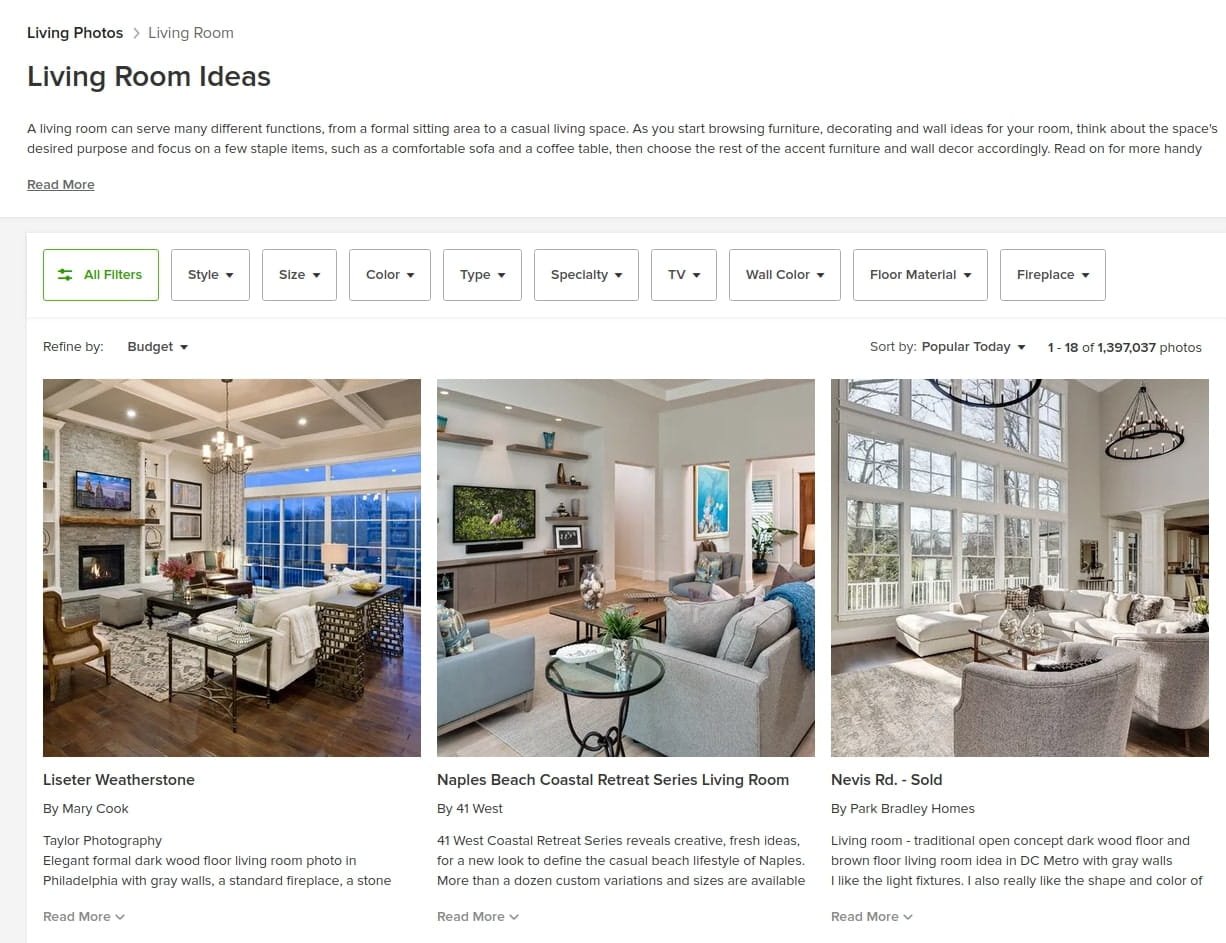
The company claims to have over 40 million unique users per month and 2.3 million active design professionals using the website regularly.
Houzz has been included in the 2019 CNBC Disruptors 50 companies and is worth $4 billion.
3. LiquidSpace
This online marketplace for renting office space was launched in 2010 by Mark Gilbreath. He noticed that the traditional real estate model doesn’t suit startups since they change space requirements quickly to adjust to the dynamics of their business. LiquidSpace was built to address this issue.
The platform connects organizations and individual workers with real estate owners offering a suitable venue via the website or mobile application.
LiquidSpace can be called an open network marketplace meaning that anyone can list their office space and set a rate they consider reasonable. Users can list and browse venues for free, however, when the transaction is made on the platform, LiquidSpace takes a 10% cut.
On the website, you can find custom offices tailored to your specific business requirements:
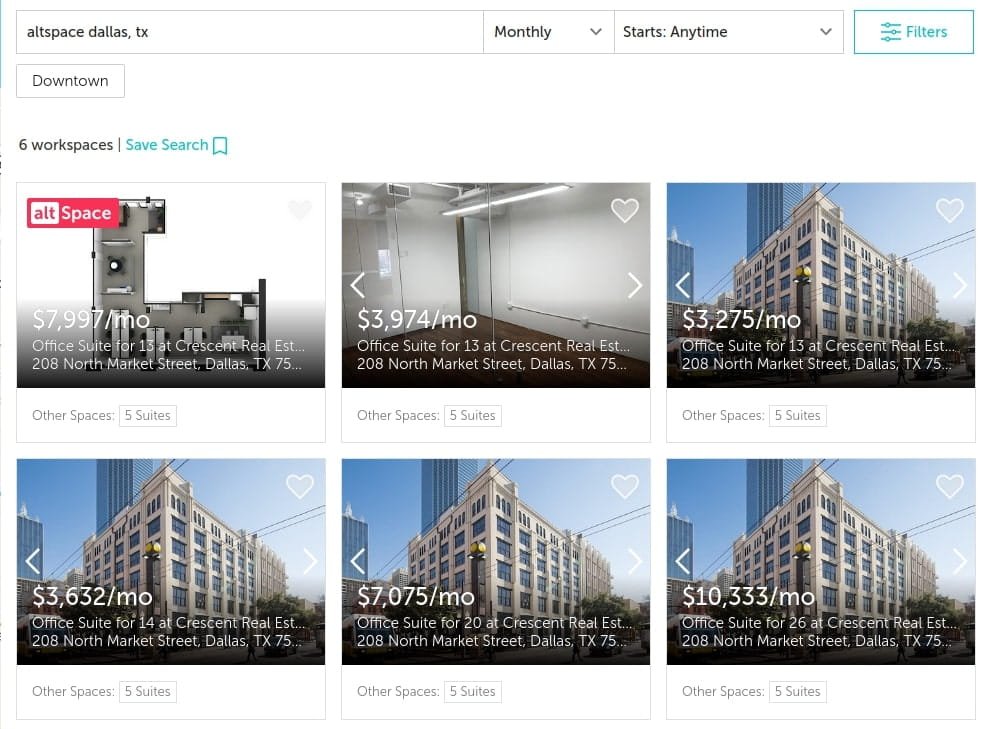
The startup has diverse clients from the staff of multinational enterprises to small companies and individual freelancers in the USA, Canada and Australia.
LiquidSpace managed to raise over $26 million with investors, including Linkedin’s co-founder Reid Hoffman.
4. StyleSeat
This beauty booking online marketplace was founded by Melody McCloskey in 2011. StyleSeat was launched to solve two important issues: to come up with a better way of choosing a proper stylist and give beauty masters a better opportunity to find and communicate with clients.
StyleSeat helps consumers search the platform to choose the right stylists or other beauty specialists. Users can check the portfolio and works of a particular professional and book an appointment.
In their turn, stylists get the chance to manage their appointments, clients lists and profiles. Besides, the freemium business model allows them to access additional tools, including email marketing or reminders.
The list of top barbers in a specific location on StyleSeat looks the following way:

The startup succeeded in raising $40 million in funding. Besides, it can boast 1.23 million of booked appointments that are worth 1.1. billion in services.
The key attributes of a profitable market network
At first sight, market networks seem to have a lot in common with online marketplaces that have become increasingly popular these days. Partly it is true. However, market networks have specific characteristics that mark them out from other platforms.
Let’s specify the major differences.
1. Focus on complex services
In recent years we have witnessed the rise of on-demand online marketplaces such as Uber or Airbnb. They offer simple services that can be measured objectively.
However, home remodeling or event planning is more complex services than simple buy-sell transactions. They require more active engagement and longer partnership. Moreover, professionals quite often have to interact with other specialists in their industry to deliver end-to-end services.
Market networks appeared to help customers bring large-scale projects into reality.
2. Importance of each client and contractor
When it comes to complex services, each client is unique, and so are the specialists they collaborate with. Each professional brings exceptional opinions, ideas, and experience to the transaction.
The importance of identity can bring owners of market network additional profit. For example, parents may want to pay a premium for a babysitter on Trusted just because they were happy with the services of this particular person in the past.
3. Close cooperation between a professional and a client
Projects on market networks usually take pretty long to complete. Both sides of the medium should communicate actively to sort out all the details. Only then they will achieve the desired result.
Сlose communication requires specific tools. These can be automatic appointment requests and follow-ups, to-do lists for every project, payment schedules, ready-to-go agreements, and others.
The template of the Client Service Agreement on Honeybook helps kickstart customer relationships quickly and professionally.

4. Free flow of referrals
It is pretty easy to find a taxi driver to get you from point A to point B. However, choosing a person who will organize your corporate party is no easy feat. You will need lots of recommendations from friends and relatives to get the right event planner.
When it comes to network market business, good old word-of-the-mouth translates into a free flow of referrals that helps you lower acquisition costs.
5. Increase of the transaction speed and customer satisfaction
Market networks provide both professionals and clients with the software required for proper collaboration. As a result, the transaction velocity is improved for both parties. The offered tools also increase the close rate on proposals and streamline the payment process.
You may also like: Building an Online Marketplace - 5 Ways to Keep Costs Down
What is more important, these instruments make the working processes efficient and leave no room for miscommunication.

Subscribe to our blog to get valuable insights from our experts.
Adoption of the market network business model: winners and losers
Although the idea of starting a market network can seem very tempting, not all entrepreneurs should follow this new trend.
Let’s find out which domains will succeed from adopting this innovative business model and which will fail.
Who will win
Jamer Currier states that industries, where specialists are not interchangeable, are best suited to the market-network business model. They include the following domains:
- Real estate;
- Travel agencies;
- Investment banking;
- Legal services;
- Healthcare;
- Event planning;
- Residential construction.
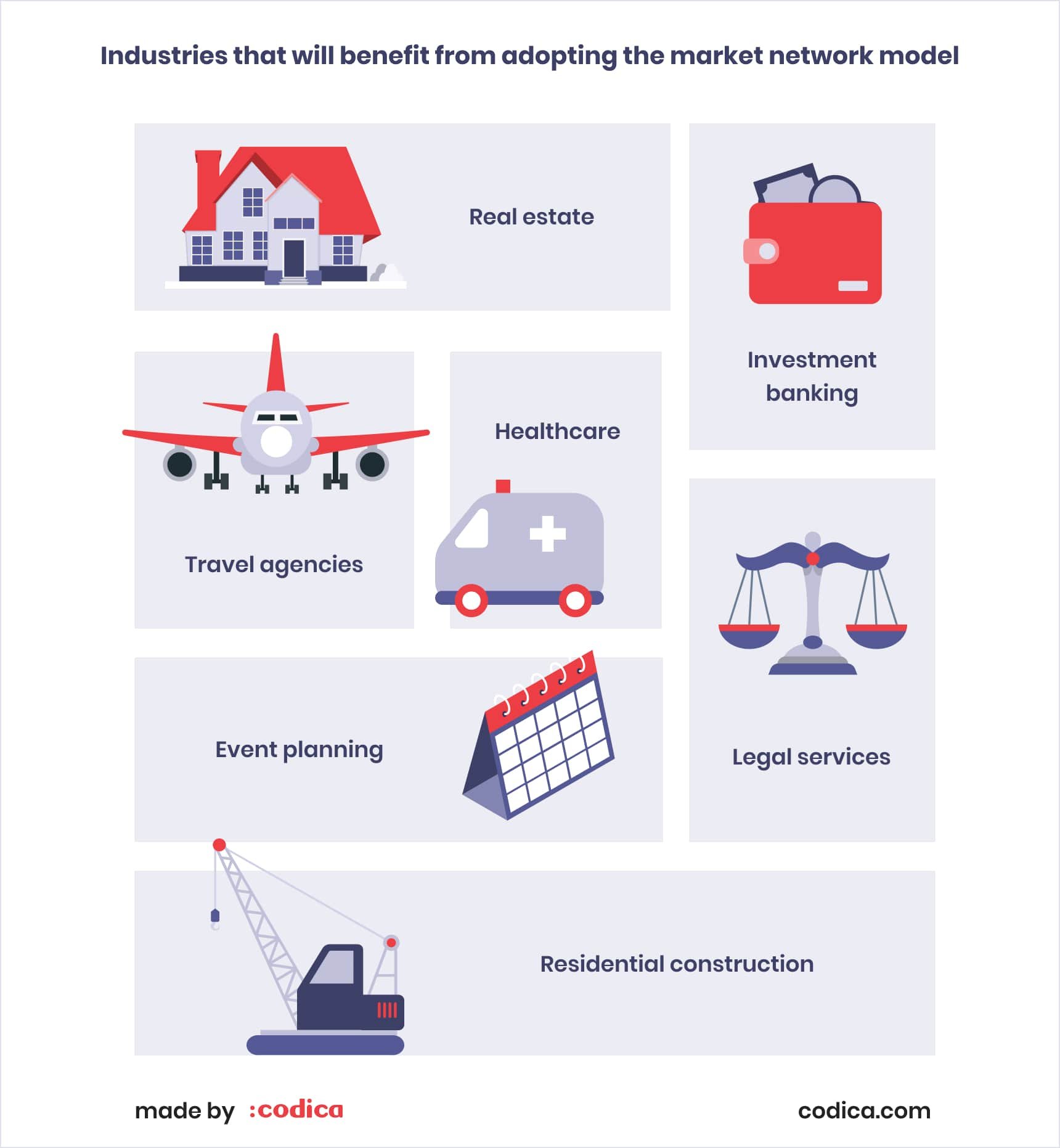
Doximity is a perfect example of how a market network can transform the healthcare industry. This social networking service unites American physicians, nurse practitioners, and clinicians.
It was created to make medical workers more productive by allowing them to share their insights into the latest healthcare trends with colleagues.
The platform offers HIPAA-secure workflow tools such as efax service, medical newsfeed, on-call scheduling, and secure calling. They allow doctors to provide more comprehensive and coordinated care.
The app for iPhone and iPad looks the following way:

Who will lose
Though market networks are on the rise, it's worth noting that like any disruptive idea, it will not suit all domains. Mark Schaefer, a keynote speaker, business consultant, and author, published an article where he listed businesses that can lose from adopting the new business model.
According to Schaefer, you should think twice before moving to market networks in the following cases:
- You are an intermediary and collect fees for your services;
- You own a traditional selling business;
- Your platform doesn’t have its ecosystem of service providers; it aggregates the demand instead.
It’s up to you to decide whether to embrace the opportunities offered by market networks or stick to familiar online marketplaces. However, if you want to provide your customers with a unique value by helping to build long-term relationships, and become a disruptor in your industry, you should definitely give this business model a try.
What’s the future of market networks?
The forecasts for the future of market networks look quite optimistic. James Currier is convinced that the bright future is waiting for them.
Will his predictions come true? Only time will tell. However, there is no denying that market networks have great potential to disrupt the traditional markets. At the end of the day, this new type of online marketplace platform may have a great impact on how service providers will do their job and earn a living.
Are you ready to build a market network and looking for a reliable technical partner? Contact us and our team will eagerly bring your project into reality.
